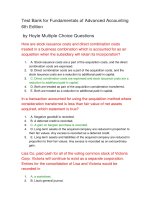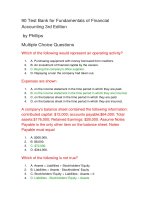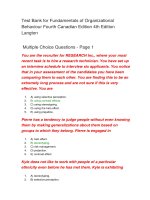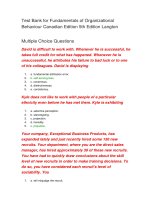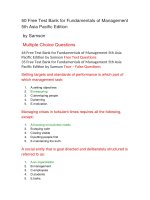Test bank for fundamentals of biochemistry voet 4th edition
Bạn đang xem bản rút gọn của tài liệu. Xem và tải ngay bản đầy đủ của tài liệu tại đây (339.5 KB, 17 trang )
Link download full of Test Bank for Fundamentals of
Biochemistry 4th Edition by Voet
CLICK HERE
Chapter 16: Glycogen Metabolism and Gluconeogenesis
Matching
Choose the correct answer from the list. Not all the answers will be used.
A)
B)
C)
D)
E)
F)
G)
H)
I)
J)
K)
L)
phosphorylase a
gluconeogenesis
glucagon
glucose-6-phosphatase
cAMP
biotin
insulin
glycogenolysis
liver
glucose-1-phosphate
dolichol
muscle
1. The breakdown of glycogen is referred to as ______.
Ans: H
Section: 16.1
Level of Difficulty: Easy
Learning Objective: Glycogen Breakdown
2. Glucose can be synthesized from noncarbohydrate precursors by______.
Ans: B
Section: Intro
Level of Difficulty: Easy
Learning Objective: Gluconeogenesis
3. Carboxylation of pyruvate in humans requires ______ as an essential dietary nutrient.
Ans: F
Section: 16.4.A
Level of Difficulty: Easy
Learning Objective: Gluconeogenesis
4. ______ activates glycogen breakdown.
Ans: E
122
full file at
Section: 16.3.B
Level of Difficulty: Easy
Learning Objective: Control of Glycogen Metabolism
5. An enzyme present in the endoplasmic reticulum of liver cells is ______.
Ans: D
Section: 16.1.C
Level of Difficulty: Moderate
Learning Objective: Glycogen Breakdown
6. ______ cells lack receptors for the hormone glucagon.
Ans: L
Section: 16.3.C
Level of Difficulty: Easy
Learning Objective: Control of Glycogen Metabolism
7. Low blood glucose (< 5mM) levels result in the release of ______.
Ans: C
Section: 16.3.C
Level of Difficulty: Easy
Learning Objective: Control of Glycogen Metabolism
8. The first step in the breakdown of glycogen is catalyzed by ______.
Ans: A
Section: 16.1.A
Level of Difficulty: Easy
Learning Objective: Glycogen Breakdown
9. Both glycogen synthesis and glycogen breakdown share the metabolite ______.
Ans: J
Section: 16.2.A
Level of Difficulty: Moderate
Learning Objective: Glycogen Breakdown & Synthesis
10. The membrane-bound polyisoprenol involved in the synthesis of N-linked glycoproteins is
called ______.
Ans: K
Section: 16.5
Level of Difficulty: Easy
Learning Objective: Other Carbohydrate Biosynthetic Pathways
Multiple Choice
11. Which of the following enzymes catalyzes the conversion of glucose-1-phosphate to glucose6-phosphate?
A)
glucose-1-isomerase
full file at
full file at
B)
C)
D)
E)
glucokinase
glucose-1-phosphatase
phosphoglucomutase
glycogen phosphorylase
Ans: D
Section: 16.1C
Level of Difficulty: Easy
Learning Objective: Glycogen Breakdown
12. Individuals with McArdle's disease lack the ____ in the ____,
A)
B)
C)
D)
E)
debranching enzyme; liver
phosphoglucomutase; liver
glycogen phosphorylase; muscle
phosphoglucomutase; muscle
glycogen phosphorylase; liver
Ans: C
Section: 16.1.C, Box 16-2
Level of Difficulty: Moderate
Learning Objective: Glycogen Breakdown, Box 16-2
13. In glycogen synthesis, the intermediate between glucose-1-phosphate and glycogen is
A)
B)
C)
D)
E)
UDP–glucose .
UDP-glycogen.
glucose-1,6-bisphosphate.
glucose-6-phosphate.
glucose.
Ans: A
Section: 16.2.A
Level of Difficulty: Easy
Learning Objective: Glycogen Synthesis
14. Which of the following aides in formation of a primer for glycogen synthesis ?
A)
B)
C)
D)
E)
glycogen synthase
UDP-glucose pyrophosphatate
glycogenin
UDP–glycogen
amylo-(1,41,6)-transglycosylase
Ans: C
Section: 16.2.B
full file at
full file at
Level of Difficulty: Moderate
Learning Objective: Glycogen Synthesis
15. Which of the following enzymes directly converts phosphorylase b into the more active form,
phosphorylase a?
A)
B)
C)
D)
E)
cAMP-dependent protein kinase
phosphorylase kinase
protein kinase A
adenylate cyclase
phosphoprotein phosphatase-1
Ans: B
Section: 16.1.A, 16.3.B
Level of Difficulty: Moderate
Learning Objective: Glycogen Breakdown, Control of Glycogen Metabolism
16. The biotin prosthetic group of pyruvate carboxylase is covalently attached to a ______
residue of the enzyme?
A)
B)
C)
D)
E)
valine
serine
lysine
arginine
the biotin is attached non-covalently
Ans: C
Section: 16.4.A
Level of Difficulty: Easy
Learning Objective: Gluconeogenesis
17. Which of the following serves as the free energy source for the metabolic conversion of
oxaloacetate to phosphoenolpyruvate, which is catalyzed by PEP carboxykinase?
A)
B)
C)
D)
E)
hydrolysis
hydrolysis
hydrolysis
hydrolysis
hydrolysis
of PPi
of ATP
of GTP
of an internal phosphoanhydride bond
of a thioester intermediate
Ans: C
Section: 16.4.A
Level of Difficulty: Easy
Learning Objective: Gluconeogenesis
full file at
full file at
18. What is the net energetic cost of converting two pyruvate to one glucose by gluconeogenesis
in ATP equivalents?
A)
B)
C)
D)
E)
2
3
4
6
8
Ans: D
Section: 16.4.B
Level of Difficulty: Moderate
Learning Objective: Gluconeogenesis
19. Muscle cells are not able to supply glucose for other tissues because
A)
B)
C)
D)
E)
they
they
they
they
they
lack
lack
lack
lack
lack
the GLUT2 transporter.
pyruvate carboxylase.
glucose-6-phosphatase.
the malate-aspartate shuttle.
glycogen phosphorylase.
Ans: C
Section: 16.1.C
Level of Difficulty: Difficult
Learning Objective: Glycogen Breakdown
20. Which of the following statements about glycogen is true?
I. Glycogen is a polymer of glucose in (16) linkages with (14) linked branches
every 8–14 residues.
II. UDP–glucose is produced from glycogen by the action of the enzyme phosphorylase.
III. In glycogen breakdown, glucose residues are sequentially removed from the
nonreducing ends.
IV. The breakdown of glycogen in skeletal muscle ultimately supplies glucose-6phosphate, which can enter glycolysis to generate ATP.
A)
B)
C)
D)
E)
I, II, III, IV
I, II
II, III, IV
III, IV
III only
Ans: D
Section: 16.1
Level of Difficulty: Difficult
Learning Objective: Glycogen Breakdown
full file at
full file at
21. Which of the following metabolic conversions does not occur in gluconeogenesis?
oxaloacetate phosphoenolpyruvate
fructose-1,6-bisphosphate fructose-6-phosphate
GTP CO2 + GDP
NADH + H+ NAD+
1,3-bisphosphoglycerate 3-phosphoglycerate
A)
B)
C)
D)
E)
Ans: E
Section: 16.4
Level of Difficulty: Moderate
Learning Objective: Gluconeogenesis
22. Which of the following is correct concerning the metabolic reaction shown below?
Pyruvate + CO 2 + ATP
oxaloacetate + ADP + Pi
I. This metabolic reaction is catalyzed by pyruvate carboxykinase.
II. The enzyme that catalyzes this reaction is activated by high concentrations
of acetyl-CoA .
III. The enzyme that catalyzes this reaction is covalently bonded to the
coenzyme pyridoxal-5ꞌ-phosphate.
IV. The enzyme that catalyzes this reaction is located in the endoplasmic
reticulum of the cell .
A)
B)
C)
D)
E)
I, II
I only
II only
II, III
II, III, IV
Ans: C
Section: 16.4.A
Level of Difficulty: Difficult
Learning Objective: Gluconeogenesis
23. What molecules correspond to correspond to X and Y in the following gluconeogenic
reaction?
Fructose-1,6-bisphosphotase + X Fructose-6-phosphate + Y
A)
B)
C)
D)
E)
X = NADH + H+
X = ATP
X = NAD+
X = GTP
X = H2 O
Y = NAD+
Y = ADP + Pi
Y = NADH + H+
Y = GTP + Pi
Y = Pi
Ans: E
Section: 16.4.B
full file at
full file at
Level of Difficulty: Moderate
Learning Objective: Gluconeogenesis
24. Which of the following metabolic conversions involved in glucose synthesis requires the
direct expenditure of ATP?
I. 3-Phosphoglycerate 1,3-bisphosphoglycerate
II. Glyceraldehyde-3-phosphate + dihydroxyacetone phosphate fructose1,6-bisphosphate
III. Fructose-1,6-bisphosphate fructose-6-phosphate
IV. 1,3-Bisphosphoglycerate glyceraldehyde-3-phosphate
A)
B)
C)
D)
E)
I only
II, III
III only
II, IV
I, IV
Ans: A
Section: 16.4.B
Level of Difficulty: Moderate
Learning Objective: Gluconeogenesis
25. Which statement is TRUE concerning the metabolic reaction shown below?
HOCH2
-2
O
OPO3-2
O3POCH2
O
OH
OH
OH
OH
A)
B)
C)
D)
E)
OH
OH
OH
The enzyme that catalyzes this reaction is called a mutase.
The enzyme that catalyzes this reaction is called a kinase.
This reaction requires the free energy of ATP hydrolysis.
This reaction requires multiple steps catalyzed by a phosphorylase and a
mutase.
The oxidation level of glucose-1-phosphate is higher than that of glucose-6phosphate.
Ans: A
Section: 16.1.C
full file at
full file at
Level of Difficulty: Moderate
Learning Objective: Glycogen Breakdown
26. The diagram represents a “substrate cycle” in glucose metabolism. Which of the following
statements about the cycle is true?
A)
B)
C)
D)
E)
Reactions I & II are catalyzed by the same enzyme and help establish
equilibrium between the two metabolites.
Reaction II produces ATP by substrate-level phosphorylation.
Reaction II is catalyzed by an allosteric enzyme that is inhibited by fructose-26-bisphosphate.
Reaction I is involved in the biosynthesis of glucose.
Reaction II occurs under low-energy conditions when the cell needs ATP.
Ans: C
Section: 16.4.C
Level of Difficulty: Difficult
Learning Objective: Gluconeogenesis
27. Increased levels of epinephrine in the blood will
I.
II.
III.
IV.
A)
B)
C)
D)
E)
activate adenylate cyclase in liver and muscle cells.
stimulate glycogen synthesis.
inhibit glycolysis in the muscle cell.
stimulate gluconeogenesis in the muscle cell.
I only
I, II
I, II, III
II only
I, II, III, IV
Ans: A
Section: 16.3.C
full file at
full file at
Level of Difficulty: Difficult
Learning Objective: Control of Glycogen Metabolism
28. Avidin, a protein intact in raw egg whites, prevents the absorption of biotin in the intestine
resulting in biotin deficiency. Which of the following is affected in individuals who consume
large amounts of raw egg?
A)
B)
C)
D)
E)
Oxaloacetate phosphoenolpyruvate
1,3-Bisphosphoglycerate glyceraldehyde-3-phosphate
Fructose-1,6-bisphosphate fructose-6-phosphate
Pyruvate oxaloacetate
Phosphoenolpyruvate 2-phosphoglycerate
Ans: D
Section: 16.4.A
Level of Difficulty: Difficult
Learning Objective: Gluconeogenesis
29. Which enzyme has an intermediate of the form presented below?
CH 2OPO 32O
H
H
OH
H
OPO 32-
OH
H
A)
B)
C)
D)
E)
H
OH
phosphofructokinase
glycogen phosphorylase
phosphohexose isomerase
phosphoglucomutase
none of the above
Ans: D
Section: 16.1.C
Level of Difficulty: Difficult
Learning Objective: Glycogen Breakdown
30. Which statement is true regarding the activation of pyruvate carboxylase by acetyl-CoA?
full file at
full file at
A)
B)
C)
D)
E)
Feedback activation enhances flux through glycolysis.
Feedforward activation enhances the entry of pyruvate through the TCA cycle
as Acetyl-CoA.
Ensures that gluconeogenesis occurs rather than pyruvate conversion to
acetyl-CoA.
Ensures that ATP is not wasted in the production of oxaloacetate.
Feedback inhibition ensures that excess glucose-6-phosphate is not produced.
Ans: C
Section: 16.1.C
Level of Difficulty: Difficult
Learning Objective: Gluconeogenesis
31. What is the net ATP yield for a muscle cell that stores one dietary glucose molecule as
glycogen and then releases it and sends it through glycolysis?
A)
B)
C)
D)
E)
0
1
2
3
4
Ans: C
Section: 16.1
Level of Difficulty: Difficult
Learning Objective: Glycogen Breakdown
32. Which of the following best describes the function of the glycogen debranching enzyme in
glycogenolysis?
A)
B)
C)
D)
E)
It cleaves (16) branch points releasing glucose-6-phosphate.
It cleaves (16) branch points releasing glucose-1-phosphate.
It cleaves (16) branch points releasing glucose.
It transfers an (14) linked trisaccharide unit to the nonreducing end of an
alternate branch, then cleaves the (16) branch point releasing glucose-1phosphate.
It transfers an (14) linked trisaccharide to the nonreducing end of an
alternate branch, then cleaves the (16) branch point releasing glucose.
Ans: E
Section: 16.1.B
Level of Difficulty: Easy
Learning Objective: Glycogen Breakdown
full file at
full file at
33. If cAMP levels are high
I. Glycogenolysis will occur in muscle cells but not liver cells.
II. Glucose released from muscle glycogen will enter glycolysis.
III. Glucose released from liver glycogen will exit liver cells via the GLUT4
transporter.
IV. Glucose will enter liver cells resulting in glycogen synthesis.
A)
B)
C)
D)
E)
I, II, IV
I, II
II, III, IV
II only
III only
Answer: D
Section: 16.3.C
Level of Difficulty: Very Difficult
Learning Objective: Control of Glycogen Breakdown
34. Which of the following best explains the energetically favorable formation of UDP–glucose
in the liver and muscle?
A)
B)
C)
D)
E)
G° for the reaction glucose-1-phosphate + UTP UDP–glucose + PPi
is very negative.
G° for the reaction glucose-1-phosphate + UTP UDP–glucose + PPi
is very positive.
G° for the reaction PPi 2Pi is very negative.
G° for the reaction PPi 2Pi is very positive.
G° for the overall reaction is very positive.
Ans: C
Section: 16.2.A
Level of Difficulty: Moderate
Learning Objective: Glycogen Synthesis
35. Hexokinase does not catalyze the final step in gluconeogenesis as written below because
full file at
full file at
glucose-6-phosphate + ADP glucose + ATP
A)
B)
C)
D)
E)
the phosphate bond in glucose-6-phosphate does not have a high enough free
energy to form ATP.
ATP inhibits hexokinase and blocks the reaction from occurring as written.
hexokinase is only reversible when high levels of ATP are present.
hexokinase does not bind glucose-6-phosphate.
none of the above
Ans: A
Section: 16.4.B
Level of Difficulty: Difficult
Learning Objective: Gluconeogenesis
36. Which of the following best describes the role of fructose-2,6-bisphosphate (FBP) in liver
cells?
A)
B)
C)
D)
E)
It is an intermediate in glycolysis.
It is an intermediate in gluconeogenesis.
It is an intermediate in both glycolysis and gluconeogenesis.
FBP is a potent allosteric activator of phosphofructokinase and an inhibitor of
fructose bisphosphatase.
FBP is a potent allosteric activator of fructose bisphosphatase and an inhibitor
of phosphofructokinase.
Ans: D
Section: 16.4.C
Level of Difficulty: Moderate
Learning Objective: Gluconeogenesis
37. Which of the following is true regarding the reaction shown below?
pyruvate + HCO 3 − + ATP oxaloacetate + ADP + Pi
I.
II.
III.
IV.
It requires the direct transport of oxaloacetate across the membrane.
It utilizes the malate-aspartate shuttle in some species.
It is essential for gluconeogenesis.
Its reactants require the function of enzymes which are only found in the
cytosol.
A) I only
B) II, III
C) II, III, IV
D) III only
E) II, IV
Ans: B
Section: 16.4.B
Level of Difficulty: Difficult
Learning Objective: Gluconeogenesis
full file at
full file at
38. The synthesis of N-linked oligosaccharides occur in the _____ while O-linked
oligosaccharides are synthesized in the ______.
A)
B)
C)
D)
E)
Golgi apparatus; endoplasmic reticulum
cytosol; Golgi apparatus
mitochondrial matrix; endoplasmic reticulum
endoplasmic reticulum; Golgi apparatus
Golgi apparatus; mitochondrial matrix
Ans: D
Section: 16.5
Level of Difficulty: Easy
Learning Objective: Other Carbohydrate Biosynthetic Pathways
39. Levels of glucose-6-phosphate (G6P) are affected by which of the following?
I. glycogen breakdown
II. activity of the pentose phosphate pathway
III. galactose preparation for entry into glycolysis
A)
B)
C)
D)
E)
I, II
I, II, III
III
II,
I, III
Ans: B
Section: 15.5, 15.6, 16.1
Level of Difficulty: Difficult
Learning Objective: Chapter 15 sections, Glygocen Breakdown
40. The breakdown of glycogen produces G1P. Which of the following is FALSE regarding
G1P?
A)
B)
C)
D)
E)
It is involved in the utilization of fructose by glycolysis in the liver.
It is involved in the utilization of fructose by glycolysis in the muscle.
It is involved in utilization of galactose by glycolysis.
It is converted to G6P by phosphoglucoisomerase (PGI).
It is produced as an intermediate in the central glycolytic sequence.
Ans: D
full file at
full file at
Section: 15.1, 15.5, 16.1C, 16.2
Level of Difficulty: Difficult
Learning Objective: Chapter 15 sections, Glycogen Breakdown, Glycogen Synthesis
41. The glycogen debranching enzyme is required for
A)
B)
C)
D)
E)
the transfer of 3-glucose units from one branch to another.
the transfer of phosphate from one position to another.
cleaving (16) sugar linkages
A and C
A, B and C
Ans: D
Section: 16.1.B
Level of Difficulty: Moderate
Learning Objective: Glycogen Breakdown
42. Which of the following describes a sequence which will ultimately activate glycogen
breakdown in a muscle?
A) epinephrine binds β receptors. cAMP PKA phosphorylase kinase
glycogen phosphorylase
B) epinephrine bind α receptors Ca2+ increase phosphorylase kinase
glycogen phosphorylase
C) glucagon glucagon receptors cAMP PKA phosphorylase kinase
glycogen phosphorylase
D) PP1 binding to unphosphorylated Gm dephosphorylates glycogen
phosphorylase and phosphorylase kinase
E) All of these will activate glycogen breakdown in a muscle.
Ans: A
Section: 16.3.C
Level of Difficulty: Difficult
Learning Objective: Control of Glycogen Metabolism
43. Phosphoprotein phosphatase -1 (PP1)
A)
B)
C)
D)
E)
catalyzes the phosphorylation of phosphorylase kinase.
increases glycogen breakdown when active.
catalyzes the dephosphorylation of phosphorylase kinase.
catalyzes the dephosphorylation of glycogen phosphorylase.
Both C and Dare correct.
full file at
full file at
Ans: E
Section: 16.3.B
Level of Difficulty: Moderate
Learning Objective: Control of Glycogen Metabolism
44. Which of the following will NOT activate glycogen phosphorylase in the liver?
A)
B)
C)
D)
E)
epinephrine
glucagon
eating a high carbohydrate meal
cAMP
All of the above will activate glycogen phosphorylase.
Ans: C
Section: 16.3.C
Level of Difficulty: Difficult
Learning Objective: Control of Glycogen Metabolism
45. Patient “G” has a glycogen storage disease which results in decreased muscle glycogen
levels. Muscle biopsies indicate poor glycogen structure in the muscle. Which of the
following enzymes might be related to the cause?
A)
B)
C)
D)
E)
muscle debranching enzyme
muscle glycogen phosphorylase
liver debranching enzyme
muscle glycogen synthase
liver glycogen synthase
Ans: D
Section: 16.1
Level of Difficulty: Difficult
Learning Objective: Glycogen Synthesis
46. Which of the following overall sequences is correct with regard to gluconeogenesis?
A)
B)
C)
D)
E)
Oxaloacetate PEP G6P Glucose
Pyruvate FBP PEP Glucose
Lactate PEP Pyruvate G6P
Oxaloacetate F6P FBP Glucose
F6P FBP Glucose G6P
Ans: A
Section: 16.4
full file at
full file at
Level of Difficulty: Moderate
Learning Objective: Gluconeogenesis
47. Which enzyme below is NOT required for the synthesis of branched glycogen?
A)
B)
C)
D)
E)
glycogen phosphorylase
glycogen synthase
branching enzyme
phosphoglucomutase
All are required for synthesis of glycogen.
Ans: A
Section: 16.1
Level of Difficulty: Easy
Learning Objective: Glycogen Synthesis
48. A deficiency in muscle glycogen phosphorylase would result in
A)
B)
C)
D)
E)
normal muscle glycogen structure.
abnormal muscle glycogen structure.
elevated muscle glycogen levels
A and C
B and C
Ans: D
Section: 16.2.A, B, C
Level of Difficulty: Moderate
Learning Objective: Glycogen Breakdown
49. The Cori cycle is effective because
A) it allows the use of the lactate generated during anaerobic glycolysis to produce
pyruvate.
B) it uses less ATP than gluconeogenesis.
C) it uses the compound DHAP and G3P generated during glycolysis to transport
reducing equivalents.
D) A and B
E) A and C
Ans: A
Section: Box 16-1, 16.1
Level of Difficulty: Moderate
Learning Objective: Glycogen Breakdown, Box 16-1
full file at
full file at
50. A deficiency in the enzyme PEPCK (PEP carboxykinase) would
A)
B)
C)
D)
E)
block function of the malate/aspartate shuttle.
block transfer of reducing equivalents across the membrane in the heart and liver.
inhibit formation of ATP via oxidative phosphorylation.
inhibit formation of NADH.
decrease flux through gluconeogenesis.
Ans: E
Section: 16.4
Level of Difficulty: Difficult
Learning Objective: Gluconeogenesis
full file at
